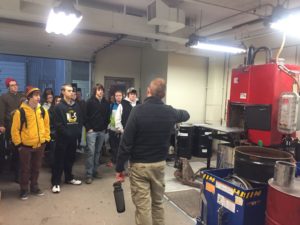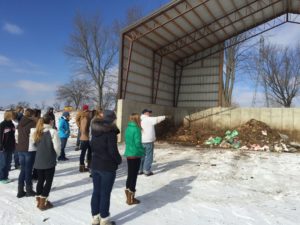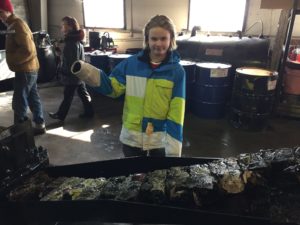By YES! Coordinator Jonathan Morales
Waste is in all of our lives whether we like it or not and that is precisely why it is so important that we consider what we are doing with it. A closed loop economy is attainable but first we have to educate ourselves on why it is important and what exactly it will take to get there.

At the Where Waste Goes (After it Goes Away) YES! Winter Workshop on February 13th, we started out in a room filled with free paint, stain, aerosols, fertilizer, and pesticide that had been cast aside. One might not think of looking for freebies at a hazardous waste facility, but at Tri-County Household Hazardous Waste (HHW) they are not looking to waste anything! During our tour at HHW with Ross Detert, we learned that about 30% of the 500,000 pounds of waste the HHW building takes in is reusable. They also collect 42,000 CFL light bulbs per year and this is all done in a building that is just about as close as you can get to LEED certification without paying for the certification.
Some of the ways they conserve energy are through well-insulated precast tilt-up walls through out the facility, using thermal breaks for areas that don’t need as much temperature regulation, in-floor heating, LED lighting, and geothermal heat. The building was constructed so that it will not need additions in the future for increased capacity but will be able to ramp up throughput. For the people that are too far out to access the facility, they even have a mobile unit that has pickup locations through out the area. The big takeaway from this tour was the importance of choosing products and the amount you use wisely so that hazardous waste is not generated in the first place.
With one tour down, we hit the road looking for more waste stopping at Stearns County Service Center to talk to some experts in the world of waste. Doug Lien, Director of the Tri-County Solid Waste Management Commission, was our first expert and got everyone thinking about the big picture. Doug has been a resource for YES! for quite some time and has done an excellent job of bringing large issues such as recycling down to a personal level. Recently, he helped the Apollo YES! team put together a video on how to compost in their lunchroom.
Our next expert was Shane Lund with St. Cloud Wastewater Treatment. He described his job as “keeping bacteria happy”. Bacteria play a vital role in breaking down the waste in the up to 16 million gallons of wastewater passing through the facility every day. Fortunately St. Cloud is on the Mississippi river, which pumps life into the city. With such a valuable resource, the treatment plant is very careful with the water that goes back into the river. At one point, they were using chlorine to treat water returning to the river but now use UV sterilization, a more environmentally friendly process of sanitizing water. Their goal is to be energy-neutral by collecting biogas from the facility to power its vital functions. Maybe one day they will even having some left over for cars outfitted to run on natural gas.

We also had a chance to talk with Adrian Miller with Republic Services Recycling and learn about tricks in recycling such as putting many plastic bags in one plastic bag so that it can be recycled and not just thrown out as single loose bags. With landfills not going away in the near future, there are still ways to put the waste to work one last time. For instance, at the Inver Grove Heights landfill they are capturing the gas produced by the landfill and using it to generate enough electricity to power 15,000 homes.
After a quick lunch, we hit the road again on our way to Tri-County Organics. There, we got to see where local organic waste (including St. Cloud Apollo High School’s) goes to be turned into fertile, beautiful soil. Thanks to the combination of brush site and food/organics waste, they have the capacity to handle about 20 tons of waste per week. Everyone was amazed to see that inside the windrow compost pile, with two years worth of waste, it was a steamy 140 degrees even though it was well below freezing outside. In order to kill any unwanted seeds or bacteria, it is necessary to add the right amount or carbon and nitrogen rich material to keep the compost cooking away.

Our last stop was at East Side Oil Company (ESOC) to learn about waste oil recycling and ESOC’s partnership with YES! teams. ESOC recycles about 1,431,000 gallons of oil and 432 tons of used oil filters every year. Now, YES! teams such as Lac qui Parle, Royalton, and Westbrook-Walnut Grove are helping raise that number by hosting public oil recycling drop off sites that also provide the team with a source of revenue through donations at the site.
Through out our day, there was a permeating theme of turning waste streams into valuable resources. When one works toward closing their waste loop, it not only shows they are responsible but is a daily, oftentimes hourly, commitment to caring for our environment.